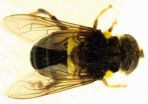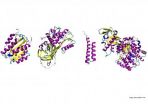(Press-News.org) Melbourne scientists have discovered how female steroid hormones can make dramatic changes to the genetic material in breast cells, changes that could potentially lead to breast cancer.
Researchers from the Walter and Eliza Hall Institute of Medical Research in Melbourne, Australia, have identified how pregnancy hormones send signals to critical molecules on the DNA to make changes in the epigenome. The epigenome is a series of chemical tags that modify DNA, controlling which genes are switched on and off.
Professor Jane Visvader, Dr Bhupinder Pal, Professor Geoff Lindeman and colleagues from the institute's breast cancer laboratory led the study, which was published today in Cell Reports.
Professor Visvader said the researchers had created a roadmap of the epigenomes of different breast cell types. In collaboration with Professor Gordon Smyth and colleagues from the institute's Bioinformatics division they determined how the epigenomes changed in response to ovarian hormones such as progesterone.
"We found the epigenome was very sensitive to hormonal regulation," Professor Visvader said. "This reveals another way in which female hormones can influence breast cancer risk - by altering the epigenome through modifications in DNA tags."
The epigenome is where the DNA and the environment intersect, communicating signals from the outside world to the DNA. The epigenome doesn't alter the genetic code, but is a layer of proteins that sits 'on top' of the DNA and provides instructions on whether DNA should be read and 'switched on' to produce proteins.
The research team found that pregnancy hormones activate a molecule called EZH2, which is an important modifier of the epigenome. "We found that hormones including progesterone activate EZH2 to modify the epigenome, leading to global changes in the expression of a huge number of genes," Professor Visvader said.
"In normal tissue, EZH2 is essential for the development of breast tissue including ducts and milk-producing cells, and for maintaining the activity of breast stem cells and their daughter progenitor cells. However, life-long exposure to hormones could lead to breast tumour initiation through increased levels of EZH2 and the changes that it orchestrates in the epigenome."
Breast cancer is the most common cause of cancer in women, accounting for almost 30 per cent of all cancers affecting women. One in nine women in Australia will develop breast cancer by the age of 85.
High levels of EZH2 are a marker of poor prognosis in breast cancer and have been frequently observed in basal-like breast cancers, the most aggressive types of breast cancer. "The link between progesterone, EZH2 and the epigenome, could be crucially important in the very early stages of breast cancer development," Professor Visvader said.
Professor Lindeman said there were decades of evidence linking hormone exposure with breast cancer, but the hormones' influence on the epigenome was not known. "Our discovery points to a role for hormone-induced changes in the epigenome in the early stages of breast cancer initiation, and could lead to new therapeutics for treating breast cancer," Professor Lindeman said. "Inhibitors against EZH2 are being developed by others, but it will be several years before we know the outcome of these on cancer."
### This project was supported by the National Health and Medical Research Council of Australia, the Victorian Government through funding of the Victorian Breast Cancer Research Consortium, the National Breast Cancer Foundation, and the Australian Cancer Research Foundation.
Study finds hormones can change the breast's genetic material
2013-01-31
ELSE PRESS RELEASES FROM THIS DATE:
Cyclone did not cause 2012 record low for Arctic sea ice
2013-01-31
It came out of Siberia, swirling winds over an area that covered almost the entire Arctic basin in the normally calm late summer. It came to be known as "The Great Arctic Cyclone of August 2012," and for some observers it suggested that the historic sea ice minimum may have been caused by a freak summer storm, rather than warming temperatures.
But new results from the University of Washington show that the August cyclone was not responsible for last year's record low for Arctic sea ice. The study was published online this week in Geophysical Research Letters.
"The ...
Electronic health records could help identify which patients most need ICU resources
2013-01-31
ANN ARBOR, Mich. — A national shortage of critical care physicians and beds means difficult decisions for healthcare professionals: how to determine which of the sickest patients are most in need of access to the intensive care unit.
What if patients' electronic health records could help a physician determine ICU admission by reliably calculating which patient had the highest risk of death?
Emerging health technologies – including reliable methods to rate the severity of a patient's condition – may provide powerful tools to efficiently use scarce and costly health resources, ...
International team observe 'hungry twin' stars gobbling their first meals
2013-01-31
AMHERST, Mass. – Just-forming stars, like growing babies, are always hungry and must "feed" on huge amounts of gas and dust from dense envelopes surrounding them at birth. Now a team of astronomers including Robert Gutermuth, a University of Massachusetts Amherst expert in imaging data from the Spitzer Space Telescope, reports observing an unusual "baby" star that periodically emits infrared light bursts, suggesting it may be twins, that is, a binary star. The discovery is reported this month in Nature.
The extremely young object, dubbed LRLL 54361, is about 100,000 years ...
Novel materials shake ship scum
2013-01-31
DURHAM, N.C. – Just as horses shake off pesky flies by twitching their skin, ships may soon be able to shed the unwanted accumulation of bacteria and other marine growth with the flick of a switch.
Duke University engineers have developed a material that can be applied like paint to the hull of a ship and will literally be able to dislodge bacteria, keeping it from accumulating on the ship's surface. This buildup on ships increases drag and reduces the energy efficiency of the vessel, as well as blocking or clogging undersea sensors.
The material works by physically ...
Biologistics: How fast do chemical trains move in living cells?
2013-01-31
The rate of chemical processes in cells is dictated by the speed of movement (diffusion) of molecules needed for a given reaction. Using a versatile method developed at the Institute of Physical Chemistry of the Polish Academy of Sciences in Warsaw, researchers were able to predict for the first time the diffusion coefficients of all proteins in Escherichia coli. The achievement is important not only for biologists and chemists, but also for... transport companies.
Understanding of chemical foundations of life requires knowledge about the rate of chemical reactions in ...
24 new species of flower fly have been found in Central and Southern America
2013-01-31
A team of scientists have described twenty four new species of dipterans belonging to Quichuana genus, of which only a further 24 species were known. The researchers, including two Spanish biologists, have been studying the forests of Central and Southern America for ten years and they have now published their results in the 'Zoological Journal of the Linnean Society'.
A ten-year study in forests of the American continent has resulted in the description of 24 new insect species from the Quichuana genus that are also known as 'flower flies'.
Up until now only a further ...
Rehabilitation therapies can lead to recovery from chronic fatigue syndrome
2013-01-31
Research led by Queen Mary, University of London, has shown that recovery from chronic fatigue syndrome (CFS) is possible for some patients, and has identified two treatments most likely to lead to recovery.
The latest results from the PACE trial* show that cognitive behaviour therapy (CBT) and graded exercise therapy (GET), as supplements to specialist medical care, increase the likelihood of recovery from CFS three-fold compared to other treatments studied. The trial, carried out in collaboration with researchers from King's College London, the University of Oxford ...
The humble 'virtual chimney' fences that could reduce the impact of airport pollution
2013-01-31
Simple 'blast' fences called baffles could deliver improvements in air quality for people living near airports, new research has found.
Placed behind a runway, the baffles could serve as a 'virtual chimney', funnelling emissions from aircraft engines upwards where they can disperse more effectively, thereby reducing the environmental impact on people living nearby.
Prototype baffles have been tested by a team of researchers from Manchester Metropolitan University, Cranfield University, University of Southampton and the University of Cambridge, with funding from the ...
Disulfiram: New support for an old addiction drug
2013-01-31
Philadelphia, PA, January 31, 2013 – Disulfiram was the first medication approved for the treatment of alcoholism over 50 years ago. It works, at least in part, by preventing the metabolism of an alcohol by-product, acetaldehyde. High levels of acetaldehyde in the body quickly cause unpleasant symptoms, including nausea, vomiting, headache, and accelerated heart rate. Thus, disulfiram provides a very strong incentive to avoid drinking.
Beginning in the late 1990s, a series of studies conducted at Yale University found that disulfiram reduced the consumption of cocaine, ...
Protein origami: Quick folders are the best
2013-01-31
Proteins are elementary building blocks of life. They often perform vital functions. In order to become active, proteins have to fold into three-dimensional structures. Misfolding of proteins leads to diseases such as Alzheimer's or Creutzfeld-Jakob. So which strategies did nature develop over the course of evolution to improve protein folding?
To examine this question, the chemist Dr. Frauke Gräter (Heidelberg Institute for Theoretical Studies) looked far back into the history of the Earth. Together with her colleague Prof. Gustavo Caetano-Anolles at the University of ...




